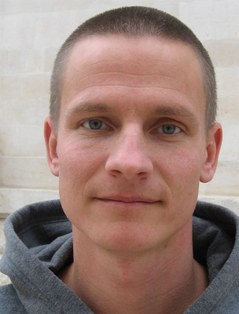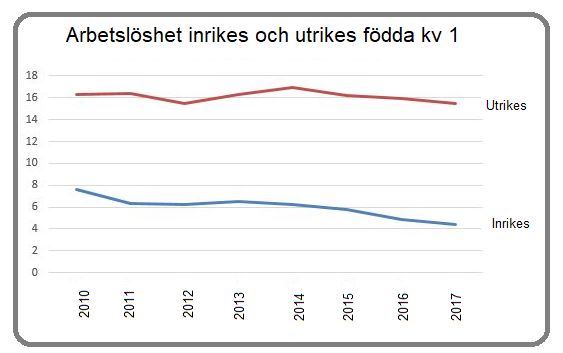Refugee immigration not primarily about money
What do refugees cost? It is a concern for both proponents and opponents of welcoming refugees to a country. Yet research shows the challenge is more social than economic, where the major risk of alienation lies in the gap between those who have a job and those who do not.
 “When we receive refugees, we are carrying out a humanitarian task, and it is important to see it as such. It has both an economic and a social cost, but we do it because we feel the moral imperative to do it,” says Joakim Ruist, a national economist and migration researcher at the University of Gothenburg.
“When we receive refugees, we are carrying out a humanitarian task, and it is important to see it as such. It has both an economic and a social cost, but we do it because we feel the moral imperative to do it,” says Joakim Ruist, a national economist and migration researcher at the University of Gothenburg.
For 30 years, Sweden has received more refugees per capita than any other Western European country. This shows that refugee immigration is economically possible and there is nothing to indicate that it threatens welfare services or the labour market. Sweden is still a welfare state, its economy is strong and there is no evidence that refugees have had an impact on the labour market in terms of lower wages or fewer jobs for native Swedes.
“Had all EU15 countries matched Sweden’s levels in the decade preceding the latest peak, five million more individuals could have been given shelter,” writes Joakim Ruist in his recently published ‘Nordic Economic Policy Review – Labour market Integration”.
He looks at the public cost of refugee immigration, and also notes that this is a complex issue. The theme is elusive, not least because research often deals with refugees as a group, comparing them to the equally diffuse group known as the native population. Few research papers, also internationally, separate the cost of refugees and even fewer look at their country of origin.
At the same time there is great interest among politicians and people in general for how much immigration costs. Yet in his paper, Joakim Ruist poses the rhetorical question – does this really reflect a genuine desire for knowledge, or is it a desire to collect arguments for one’s position? Conclusions are easily held hostage by people on both sides of the argument.
The different faces of immigration
Talking to Joakim Ruist, it is noticeable how careful he is with how words are defined. If someone counters “it is too expensive” – what is too expensive? And if you talk about the cost or contribution of immigration to society, who are we talking about? Immigrants can be highly educated experts who contribute to both productivity and public revenues, and who belong to the elite which all countries want as immigrants.
They can also be synonymous with “the Polish plumber”, i.e. the competent Eastern European manual worker who arrived after the EU expansion. They have often filled the labour deficit, easing the bottlenecks which prevented growth and productivity. They are also considered to contribute to public revenues, albeit not to the same extent as the experts.
Refugees as a group have the largest economic impact, while they also represent the part of immigration which countries can control. Global competition will feed off talents, and the Eastern European manual labourers can move freely within the EU. Unlike the other groups of immigrants, refugees do not primarily arrive to find work, but to seek shelter. It is naive to think it is easy for people to find jobs after fleeing thousands of miles and ending up in a country with a highly skilled labour market.
Not too high expectations
“There are good reasons for why integration is poor, and we should be mindful of the fact that it is difficult. People do not flee in order to find a job, so it is important to curb our expectations, or go after people who have made mistakes. There is a risk that we begin to think ‘we shouldn’t have accepted so many’. But this does not mean we can sit back and relax – quite the opposite. The graphs we now see are results of us taking action,” says Joakim Ruist.
It takes on average seven years for a refugee to find work, and during that time he or she represents a net cost to society, i.e. a public economic deficit. Hence speeding up refugees’ entry into the labour market is a priority for politicians in the Nordic countries. The question is whether we can learn from each other. Both Norway and Denmark are quicker to get refugees into the labour market, but after a few years this evens out, and the graphs for both countries flat-line before turning down a bit for both men and women in Denmark, and down somewhat for men in Norway. In Sweden it takes longer for refugees to enter the labour market, but the graph then rises slowly but surely. Why this is the case, neither Joakim Ruist or his colleagues know.
“We know very little about the slight decline we witness in Norway and Denmark. It is difficult to explain and we know very little about it. We do not see the same tendency in Sweden at all. Here, the graph rises, albeit slower than with our Nordic neighbours,” he says.
Sweden can still look like Sweden
The employment graphs he has been looking at go back 10 to 15 years, and do not take in the large group of refugees which arrived in the autumn of 2015, when some 10,000 refugees arrived every week. Joakim Ruist’s rough estimate is that some 50 billion Swedish kronor (€5.10m) were reallocated to handle the refugee flow. That is one percent of Sweden’s GDP, and around three to four percent of the public sector’s total turnover. Exact costs are hard to calculate.
“This is considerable sums of money, and they have to be taken from somewhere – which could impact on the welfare system. At the same time, it is very far from costing so much that we would have to change our welfare model. If, however, 10,000 people kept coming every week for many years, the system would have been challenged, but we are far from those levels. No, Sweden can still look like Sweden, despite the large flow of refugees which arrived then,” says Joakim Ruist.
Joakim Ruist writes a blog about his research. He is also a lecturer, and took part in the live TV ‘Migration day’ which was broadcast last autumn, one year after the large refugee influx. He established then, like he does in his blog, that fiscal issues around the refugees arriving in Sweden are not key.
“Some indicators go up and some go down, but none of them are major. What we should care about are the social gaps. There are now more refugees waiting to enter the labour market in the near future. We risk ending up with a sizeable group who are without work for a longer period of time, and work is the most important thing to fight alienation. The most important socio-economic gap in Sweden exists between those who have a job and those who do not,” said Joakim Ruist during the Migration day.
You were also asked whether immigration represents a threat to the Swedish model?
“If we think a bit deeper about the Swedish model and consider it to be the attitude that built Sweden, where we help each other to create something and take care of people who need help, then a generous refugee policy is part of it. Many are fleeing, and we need to welcome them in order to continue building on our solidarity. In the long run this is about maintaining the attitudes which built Sweden and which have made Sweden strong,” says Joakim Ruist.
- A very strong Swedish labour market
-
A fresh report from the Swedish Public Employment Service shows the country has a strong labour market. The labour supply is set to grow by 149,000 people in 2017 and 2018, and labour participation is expected to grow both among people of foreign and domestic heritage.
Eight in ten of the new jobs are expected to go to people of foreign heritage. The private and public service sectors are responsible for the majority of the job growth.
Unemployment levels are set to fall from 7 to 6.6 percent in 2017. In 2018 it is expected to grow to 6.7 percent as more people will be registered as jobseekers. Unemployment levels are expected to continue to fall among people of domestic heritage, but will grow somewhat among people of foreign heritage. This year there will be more people registering with the employment service, because a sizeable proportion of the high number of refugees arriving in the autumn of 2017 are now trying to find work. The number of registered unemployed of foreign heritage is predicted to grow from 50 to 60 percent towards the end of 2017/2018.
In 2018, registered unemployed with a weaker position in the labour market are expected to represent 78 percent of all registered unemployed. The group consists of non-European older people between 55 and 64, people with disabilities which reduces their working ability and unemployed people with no upper secondary education. 130,000 of those registered with the employment service have no upper secondary education. 90,000 of them are of foreign heritage.
(Source: Swedish Public Employment Service)

The graph shows unemployment levels for people of domestic and foreign heritage for the first quarter of each year.
 Follow us on Facebook
Follow us on Facebook
